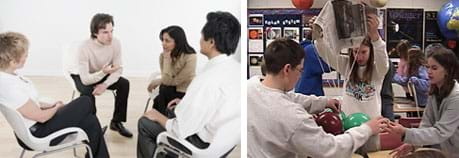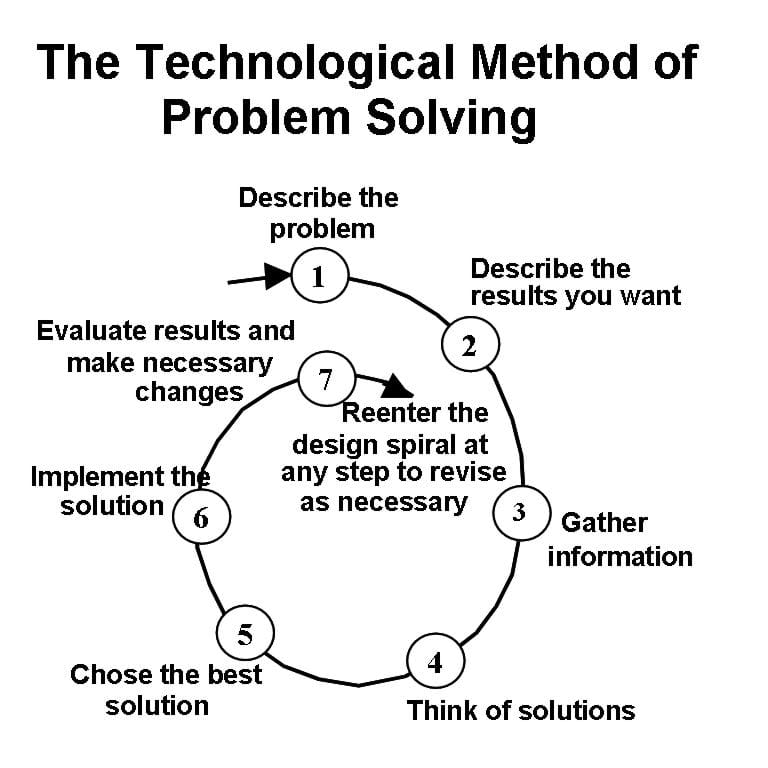Quick Look
Grade Level: 8 (6-8)
Time Required: 45 minutes
Expendable Cost/Group: US $0.00
Group Size: 0
Activity Dependency:
Subject Areas: Physical Science, Science and Technology
NGSS Performance Expectations:

| MS-ETS1-1 |

Summary
The culminating energy project is introduced and the technical problem solving process is applied to get students started on the project. By the end of the class, students should have a good perspective on what they have already learned and what they still need to learn to complete the project.Engineering Connection
Scientists, engineers and people around the world problem solve every day to work out solutions to all sorts of challenges. Using a systematic and iterative procedure to solve problems is efficient and provides a logical flow of knowledge and progress.
Learning Objectives
After this activity, students should be able to demonstrate an understanding of the technological method of problem solving, and be able to apply the method to a real-life problem.
Educational Standards
Each TeachEngineering lesson or activity is correlated to one or more K-12 science,
technology, engineering or math (STEM) educational standards.
All 100,000+ K-12 STEM standards covered in TeachEngineering are collected, maintained and packaged by the Achievement Standards Network (ASN),
a project of D2L (www.achievementstandards.org).
In the ASN, standards are hierarchically structured: first by source; e.g., by state; within source by type; e.g., science or mathematics;
within type by subtype, then by grade, etc.
Each TeachEngineering lesson or activity is correlated to one or more K-12 science, technology, engineering or math (STEM) educational standards.
All 100,000+ K-12 STEM standards covered in TeachEngineering are collected, maintained and packaged by the Achievement Standards Network (ASN), a project of D2L (www.achievementstandards.org).
In the ASN, standards are hierarchically structured: first by source; e.g., by state; within source by type; e.g., science or mathematics; within type by subtype, then by grade, etc.
NGSS: Next Generation Science Standards - Science
| NGSS Performance Expectation | ||
|---|---|---|
|
MS-ETS1-1. Define the criteria and constraints of a design problem with sufficient precision to ensure a successful solution, taking into account relevant scientific principles and potential impacts on people and the natural environment that may limit possible solutions. (Grades 6 - 8) Do you agree with this alignment? |
||
| Click to view other curriculum aligned to this Performance Expectation | ||
| This activity focuses on the following Three Dimensional Learning aspects of NGSS: | ||
| Science & Engineering Practices | Disciplinary Core Ideas | Crosscutting Concepts |
| Define a design problem that can be solved through the development of an object, tool, process or system and includes multiple criteria and constraints, including scientific knowledge that may limit possible solutions. Alignment agreement: | The more precisely a design task's criteria and constraints can be defined, the more likely it is that the designed solution will be successful. Specification of constraints includes consideration of scientific principles and other relevant knowledge that is likely to limit possible solutions. Alignment agreement: | All human activity draws on natural resources and has both short and long-term consequences, positive as well as negative, for the health of people and the natural environment. Alignment agreement: The uses of technologies and any limitations on their use are driven by individual or societal needs, desires, and values; by the findings of scientific research; and by differences in such factors as climate, natural resources, and economic conditions.Alignment agreement: |
International Technology and Engineering Educators Association - Technology
-
Design involves a set of steps, which can be performed in different sequences and repeated as needed.
(Grades
6 -
8)
More Details
Do you agree with this alignment?
-
Brainstorming is a group problem-solving design process in which each person in the group presents his or her ideas in an open forum.
(Grades
6 -
8)
More Details
Do you agree with this alignment?
-
Analyze how the creation and use of technologies consumes renewable and non-renewable resources and creates waste.
(Grades
6 -
8)
More Details
Do you agree with this alignment?
-
Critue whether existing and proposed technologies use resources sustainably.
(Grades
9 -
12)
More Details
Do you agree with this alignment?
State Standards
National Science Education Standards - Science
-
Identify questions that can be answered through scientific investigations. Students should develop the ability to refine and refocus broad and ill-defined questions. An important aspect of this ability consists of students' ability to clarify questions and inquiries and direct them toward objects and phenomena that can be described, explained, or predicted by scientific investigations. Students should develop the ability to identify their questions with scientific ideas, concepts, and quantitative relationships that guide investigation.
(Grades
5 -
8)
More Details
Do you agree with this alignment?
-
Recognize and analyze alternative explanations and predictions. Students should develop the ability to listen to and respect the explanations proposed by other students. They should remain open to and acknowledge different ideas and explanations, be able to accept the skepticism of others, and consider alternative explanations.
(Grades
5 -
8)
More Details
Do you agree with this alignment?
-
Identify appropriate problems for technological design. Students should develop their abilities by identifying a specified need, considering its various aspects, and talking to different potential users or beneficiaries. They should appreciate that for some needs, the cultural backgrounds and beliefs of different groups can affect the criteria for a suitable product.
(Grades
5 -
8)
More Details
Do you agree with this alignment?
-
Design a solution or product. Students should make and compare different proposals in the light of the criteria they have selected. They must consider constraints--such as cost, time, trade-offs, and materials needed--and communicate ideas with drawings and simple models.
(Grades
5 -
8)
More Details
Do you agree with this alignment?
-
Implement a proposed design. Students should organize materials and other resources, plan their work, make good use of group collaboration where appropriate, choose suitable tools and techniques, and work with appropriate measurement methods to ensure adequate accuracy.
(Grades
5 -
8)
More Details
Do you agree with this alignment?
-
Evaluate completed technological designs or products. Students should use criteria relevant to the original purpose or need, consider a variety of factors that might affect acceptability and suitability for intended users or beneficiaries, and develop measures of quality with respect to such criteria and factors; they should also suggest improvements and, for their own products, try proposed modifications.
(Grades
5 -
8)
More Details
Do you agree with this alignment?
-
Scientific inquiry and technological design have similarities and differences. Scientists propose explanations for questions about the natural world, and engineers propose solutions relating to human problems, needs, and aspirations. Technological solutions are temporary; technologies exist within nature and so they cannot contravene physical or biological principles; technological solutions have side effects; and technologies cost, carry risks, and provide benefits.
(Grades
5 -
8)
More Details
Do you agree with this alignment?
-
Technological solutions have intended benefits and unintended consequences. Some consequences can be predicted, others cannot.
(Grades
5 -
8)
More Details
Do you agree with this alignment?
-
Technology influences society through its products and processes. Technology influences the quality of life and the ways people act and interact. Technological changes are often accompanied by social, political, and economic changes that can be beneficial or detrimental to individuals and to society. Social needs, attitudes, and values influence the direction of technological development.
(Grades
5 -
8)
More Details
Do you agree with this alignment?
New York - Science
-
Define the criteria and constraints of a design problem with sufficient precision to ensure a successful solution, taking into account relevant scientific principles and potential impacts on people and the natural environment that may limit possible solutions.
(Grades
6 -
8)
More Details
Do you agree with this alignment?
Materials List
No materials for this activity except the attached Energy Project Worksheet.
Worksheets and Attachments
Visit [www.teachengineering.org/activities/view/cla_problem_solving_activity2] to print or download.Introduction/Motivation

The first step in solving a problem is to understand what you want to accomplish. It is critical that you identify what you already know about the problem, as well as what you need to learn.
In this activity we will apply the Technological Method of Problem Solving to get started on the energy project. The energy "problem" discussed thus far includes issues related to a limited supply of fossil fuels, carbon dioxide emissions and other air pollutants. Engineers have been developing solutions to this problem. Some of the solutions help to make devices such as cars use fuel more efficiently. Other solutions focus on identifying new energy resources that we can extract for useful work or power.The development of renewable energy resources should help to make our energy systems more sustainable for the future.
Individuals can also make decisions and choices that help to address our energy challenges. People can choose to use less energy (conservation), buy products that use energy more efficiently (efficiency), or install new energy systems for their homes (new sources). Individuals are solely responsible for decisions related to conservation. Both engineers and consumers are responsible for making and purchasing energy-efficient products or equipment to utilize renewable energy sources (for example, solar panels). In the energy project introduced today, solutions that conserve energy, use energy more efficiently or introduce new energy sources could be appropriate.
Procedure
Before class:
- Make copies of the worksheet, one per student, which includes the energy problem statement.
With the students:
- Project or draw the problem solving spiral diagram on the board. Discuss what we now know about the nature of the energy problem (limited fossil fuels, over consumption, global warming etc.) and possible solutions (conservation, efficiency, renewable sources). The students have learned about these issues already through the energy choices game and graphing activity.
- Define the goal of this unit: To complete a project to start to address the problems associated with this energy crisis. We certainly cannot expect to solve this entire problem in a few weeks!
- Hand out the worksheets, which includes the energy project description. Goal of today's class is to start to understand the problem and identify what we need to learn soon to complete this project.
- Support the groups by asking probing questions related to what they have recently learned (for example, some of the issues raised in the energy choices game).
- Closure: Have students regroup and share their ideas. Collect worksheets.
Assessment
Collect and review worksheets to evaluate students' understanding of the overall process and the particulars of this specific project.
Subscribe
Get the inside scoop on all things TeachEngineering such as new site features, curriculum updates, video releases, and more by signing up for our newsletter!More Curriculum Like This

Students are introduced to a systematic procedure for solving problems through a demonstration and then the application of the method to an everyday activity. The unit project is introduced to provide relevance to subsequent lessons.

A process for technical problem solving is introduced and applied to a fun demonstration. Given the success with the demo, the iterative nature of the process can be illustrated.
Other Related Information
This activity was originally published by the Clarkson University K-12 Project Based Learning Partnership Program and may be accessed at http://internal.clarkson.edu/highschool/k12/project/energysystems.html.
Copyright
© 2013 by Regents of the University of Colorado; original © 2008 Clarkson UniversityContributors
Susan Powers; Jan DeWaters; and a number of Clarkson and St. Lawrence students in the K-12 Project Based Learning Partnership ProgramSupporting Program
Office of Educational Partnerships, Clarkson University, Potsdam, NYAcknowledgements
This activity was developed under National Science Foundation grant nos. DUE 0428127 and DGE 0338216. However, these contents do not necessarily represent the policies of the National Science Foundation, and you should not assume endorsement by the federal government.
Last modified: August 16, 2023








User Comments & Tips